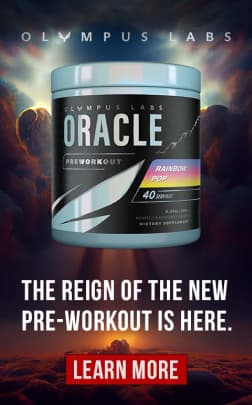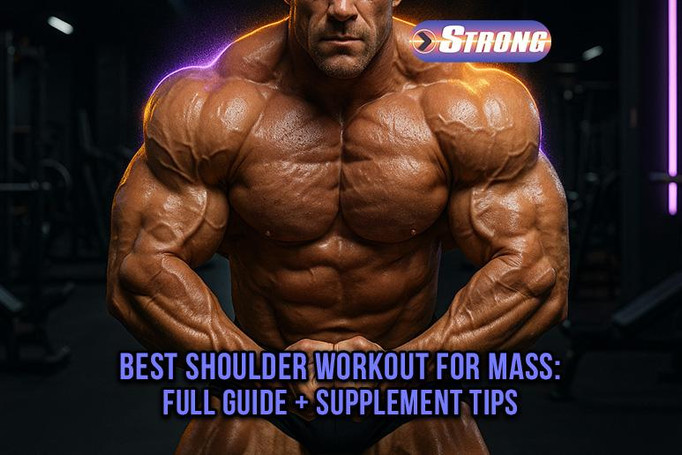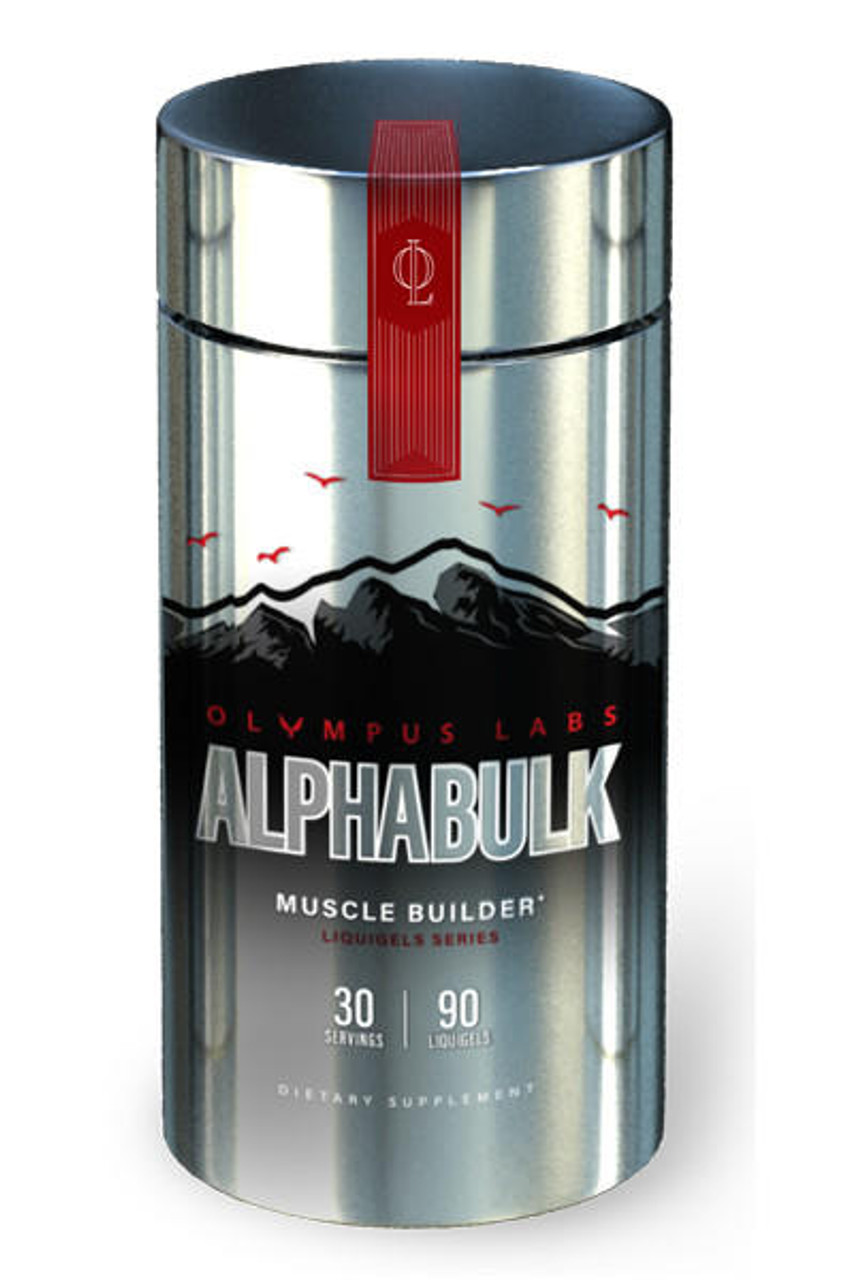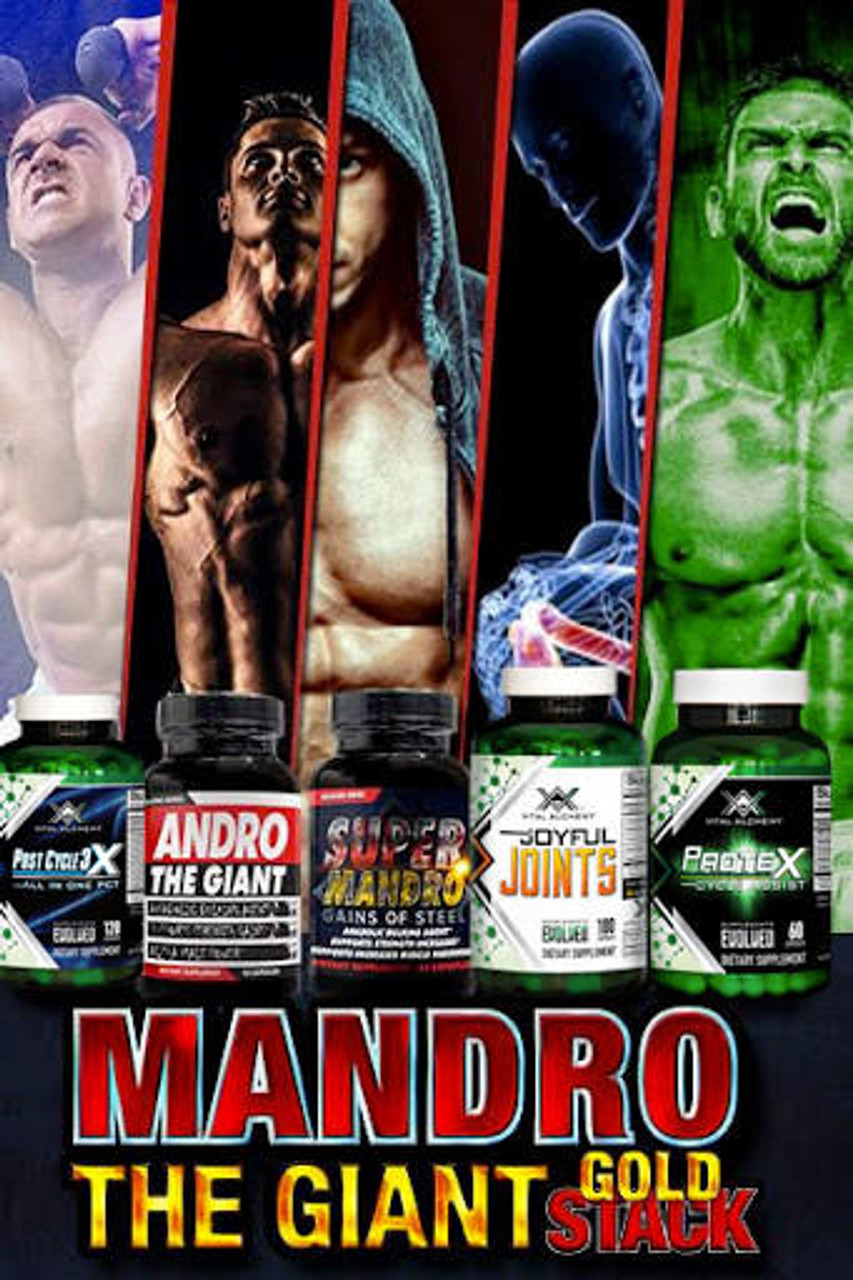Best Shoulder Workout for Mass: Full Guide + Supplement Tips
Posted by Leonard Shemtob on May 09, 2025
Introduction
Are you tired of struggling with small, underdeveloped shoulders that disappear when you turn sideways? Building impressive, three-dimensional deltoids requires more than just random pressing movements.
This comprehensive guide breaks down exactly how to build massive shoulders through proper exercise selection, optimal training techniques, and supplement recommendations backed by science.
Whether you're a beginner or advanced lifter, you'll discover the exact strategies needed to transform your shoulders from flat to phenomenal.
Short Summary:
- Proper shoulder training requires targeting all three deltoid heads for complete, balanced development
- Understanding the science of shoulder hypertrophy maximizes your results and prevents plateaus
- Compound movements build the foundation while isolation exercises sculpt detailed definition
- Optimal form and training frequency prevent injuries while stimulating maximum muscle growth
- Progressive overload and advanced techniques break through stubborn growth plateaus
- Boost your shoulder development now with the Best Natural Performance and Muscle Boosting supplement for faster and more noticeable results!
Understanding Shoulder Anatomy for Maximum Growth
The shoulder is one of the most complex joints in the body, consisting of three major muscle heads that must all be trained for complete development. The anterior (front) deltoid is activated during pressing movements like shoulder press. The lateral (side) deltoid gives shoulders their width and is targeted with lateral raises. The posterior deltoid muscles (rear delts) create depth and are often the most neglected, requiring focused rear delt exercises.
Your rotator cuff muscles play a crucial role in shoulder stability and must be kept healthy to support heavy training. These small but vital muscles include the supraspinatus, infraspinatus, teres minor, and subscapularis. Neglecting these stabilizers can lead to shoulder pain and stalled progress.
The shoulder blades (scapulae) also need attention during training. Proper scapular retraction during pulling exercises helps build a strong foundation for shoulder health and performance. Upper back muscles work synergistically with the shoulders, so developing them properly improves overall shoulder function. When these fundamentals are understood, you can train with purpose rather than just going through the motions.
The Science Behind Shoulder Hypertrophy
Shoulder muscle growth follows the same principles as other muscle groups but has unique considerations. The deltoid muscles contain a mix of fast-twitch and slow-twitch muscle fibers, with a higher percentage of fast-twitch fibers that respond best to heavier weights and moderate rep ranges (8-12 reps).
Progressive overload is essential for continued shoulder development. This means gradually increasing weight, reps, sets, or decreasing rest periods over time. Without this progression, your shoulders will quickly adapt and stop growing.
Time under tension also plays a vital role in shoulder hypertrophy. Controlling the eccentric (lowering) phase of each exercise for 2-3 seconds maximizes muscle fiber recruitment and stimulates greater growth. This technique is especially effective for stubborn lateral delts that often lag behind.
Mind-muscle connection is particularly important for shoulder training. Research shows that consciously focusing on contracting the targeted deltoid head increases muscle activation by up to 22%. This mental engagement transforms mediocre movements into growth-triggering stimuli for building muscle mass in all three heads of the shoulder.
Essential Compound Movements for Shoulder Mass
The overhead shoulder press (military press) is the king of shoulder builders. Whether performed standing or seated, with barbells or dumbbells, this movement builds the foundation of shoulder mass. Start with feet shoulder width apart, grip the bar with an overhand grip just outside shoulder width, and press directly overhead while maintaining knees slightly bent for stability.
The seated barbell press is another excellent compound movement that allows for heavier loading by eliminating the need to stabilize your core. This focused pressing movement directly targets the anterior deltoid and triceps while minimizing lower body involvement.
The push press allows you to handle heavier weights by adding a slight leg drive. This builds tremendous power through the shoulders and triceps. The increased load stimulates more muscle fibers than strict pressing alone.
Incline bench pressing at a 30-45 degree angle hits the anterior deltoid effectively while also engaging the upper chest. This compound movement builds the front shoulder/chest tie-in that creates an impressive upper body workout effect.
The upright row, when performed with proper form (elbows never higher than shoulders), effectively targets both the lateral and anterior deltoid heads. Use a shoulder-width grip to minimize wrist strain and maximize deltoid engagement.
Key Isolation Exercises for Complete Deltoid Development
Dumbbell lateral raises are the most effective isolation exercise for building wide, capped shoulders. Start with arms straight and a slight bend in the elbows, palms facing your body. Raise the dumbbells to shoulder height, maintaining a slight forward lean to optimize lateral deltoid activation.
Posterior delts require dedicated attention through exercises like bent-over rear delt flyes. Whether performed bent over, on an incline bench, or with cables, keeping your shoulder blades retracted throughout the movement ensures proper posterior deltoid activation. This exercise builds the "3D" look from behind.
Dumbbell front raises target the anterior deltoid specifically. Though this head gets work during pressing, isolation can create detailed definition. Keep your abdominal muscles tight throughout the movement to prevent excessive arching in your lower back as you raise the weight to shoulder height.
Face pulls are a hybrid movement that targets both the rear delts and rotator cuff muscles. This exercise is invaluable for building shoulder stability and preventing the common imbalance between front and rear deltoids that leads to poor posture and injury.
The best shoulder exercises for isolation include variations of these movements. A dumbbell shoulder workout allows for greater range of motion and unilateral development compared to barbell exercises, making them essential in any effective shoulder workout.
Perfect Shoulder Training Form for Maximum Results
Starting position is critical for all shoulder exercises. For overhead presses, the elbows should be directly under the wrists with shoulders pulled back and down. For dumbbell lateral raise exercises, begin with a slight bend in the elbows that remains constant throughout the movement to protect the joint during shoulder flexion.
Control the eccentric (lowering) phase of each repetition. Lowering weights too quickly reduces tension and increases injury risk. A 2-3 second lowering phase maximizes growth stimulus while protecting the shoulder joint.
For dumbbell shoulder exercises such as the DB Shoulder Press, start with the weights at shoulder height, palms facing forward or neutral (palms facing each other). Press the weights directly overhead until your arms are straight but not locked, then lower under control. This exercise targets all three heads with emphasis on the anterior deltoid.
Avoid excessive momentum. While some body English is acceptable for the last few reps of heavy sets, most repetitions should be performed with strict form. Swinging weights primarily engages the traps rather than the deltoids.
Maintain scapular retraction during pressing movements to protect the shoulder joint and optimize force production. This position creates a stable platform from which to press and reduces strain on the rotator cuff, helping to avoid shoulder pain during training.
Optimal Training Volume and Frequency for Shoulder Growth
Most lifters see optimal results training shoulders 1-2 times per week with 12-20 total working sets. This volume balances sufficient stimulus for growth with adequate recovery time. Beginners should start on the lower end of this range and gradually increase volume as they advance.
Shoulder training frequency depends on your split. If you follow a push/pull/legs routine, shoulders may get trained twice weekly. For body part splits, a dedicated shoulder workout once per week with sufficient volume works well for developing muscular shoulders.
Rest periods between sets should be 60-90 seconds for isolation movements and 2-3 minutes for compound exercises. This timing optimizes both muscle growth and strength gains while maintaining training efficiency.
Training to muscular failure has its place but should be used strategically. Take isolation exercises to failure more frequently than compound movements, which can overly tax the central nervous system if taken to failure too often. For shoulder strength training, keeping 1-2 reps in reserve on compound movements is often optimal.
Complete Shoulder Mass Workout Routines for Different Experience Levels
Beginner Shoulder Workout:
- Dumbbell Shoulder Press: 3 sets of 10-12 reps
- Dumbbell Lateral Raises: 3 sets of 12-15 reps
- Rear Delt Flyes: 3 sets of 12-15 reps
- Face Pulls: 2 sets of 15-20 reps
Intermediate Shoulder Workout:
- Standing Barbell Press: 4 sets of 6-10 reps
- Seated Dumbbell Press: 3 sets of 8-12 reps
- Upright Rows: 3 sets of 10-12 reps
- Dumbbell Lateral Raises: 4 sets of 10-15 reps
- Bent-Over Rear Delt Flyes: 3 sets of 12-15 reps
- Face Pulls: 3 sets of 15-20 reps
Advanced Shoulder Workout:
- Push Press: 5 sets of 5-8 reps
- Seated Barbell Press: 4 sets of 8-10 reps
- Upright Rows: 3 sets of 10-12 reps
- Superset: Dumbbell Lateral Raises & Dumbbell Front Raises: 4 sets of 10-12 reps each
- Superset: Rear Delt Flyes & Face Pulls: 3 sets of 12-15/15-20 reps
- Drop Set: Lateral Raises: 2 sets to failure
This effective shoulder workout routine ensures all the muscles of the shoulder complex are targeted appropriately, promoting balanced development and reducing injury risk.
Modifications for Different Fitness Levels
Beginners should focus on mastering proper form with lighter weight before progressing to heavier loads. Use machines when available to learn movement patterns with reduced risk. The Smith machine for shoulder presses provides stability while developing coordination.
For those dealing with shoulder pain, modify exercises by using neutral grip variations during pressing movements. Keep the elbows closer to the body and use a more controlled tempo to reduce stress on the joint while still stimulating the upper arm and shoulder muscles.
Intermediate lifters can incorporate more free weight exercises and begin using techniques like supersets to increase training intensity. This is also the time to ensure balance between all three deltoid heads with a dedicated shoulder workout routine.
Advanced lifters should implement periodization, varying intensity and volume over time. Training blocks focusing on strength (lower reps, higher weight) followed by hypertrophy blocks (moderate reps, moderate weight) prevents plateaus and overtraining.
Those with shoulder mobility issues can modify exercises by using neutral grip variations, reducing range of motion temporarily, or substituting problematic movements with alternatives that don't cause pain. Always prioritize shoulder health over momentary training intensity.
Common Mistakes That Limit Shoulder Development
Neglecting posterior delts is the most common mistake in shoulder training. The posterior deltoid muscles are critical for balance and the 3D look from all angles. Include at least 2 dedicated rear delt exercises in each shoulder workout.
Overtraining the anterior deltoid through too much pressing can create imbalances. The front delt gets significant work during chest training, so balance this with adequate lateral and rear deltoid work.
Using momentum instead of muscle tension reduces effectiveness. Swinging weights engages the traps and other muscle groups at the expense of deltoid development. Control the weight throughout the entire range of motion.
Training with too heavy weights often leads to poor form and reduced deltoid engagement. Choose weights that allow proper form while still challenging all the muscles in the target rep range.
Neglecting shoulder stability work can lead to injury. Include rotator cuff exercises and face pulls as preventative maintenance for long-term shoulder health and consistent progress in your shoulder strength training program.
Safety Considerations for Shoulder Training
The shoulder joint has tremendous mobility but limited stability, making lifters prone to shoulder injuries. Proper warm-up is essential before heavy shoulder training. Include arm circles, band pull-aparts, and light rotator cuff exercises to prepare the joint.
Avoid barbell upright rows with a narrow grip, as this can cause impingement. If performing upright rows, use a wider grip with elbows never rising above shoulder height.
Behind-the-neck presses put the shoulder in a vulnerable position and should be avoided by most lifters, especially those with existing shoulder pain or limited mobility.
Listen to your body and distinguish between productive muscle fatigue and joint pain. Sharp pain is always a warning sign to modify or stop an exercise immediately.
Maintain proper posture with knees slightly bent during standing shoulder exercises to protect your lower back. Keep your abdominal muscles engaged to stabilize your core and allow proper shoulder flexion without compensation.
Progression Strategies for Continued Shoulder Growth
Double progression is an effective method for continual advancement. Pick a rep range (e.g., 8-12) and when you can complete all sets at the top of the range with good form, increase the weight and start at the bottom of the range again.
Periodization prevents plateaus by systematically varying volume and intensity. Spend 4-6 weeks in a hypertrophy phase (8-12 reps), followed by 2-3 weeks of strength work (4-6 reps), then a week of higher rep deload (15-20 reps) before returning to hypertrophy training.
Exercise rotation maintains steady progress. While keeping the core movements consistent, rotate secondary exercises every 4-6 weeks to provide new stimuli and prevent adaptation in your upper body workout routine.
Micro-loading helps overcome plateaus in overhead pressing. Using 1.25-pound plates allows for 2.5-pound increases when the standard 5-pound jump feels too large.
Training density progression involves reducing rest periods over time while maintaining weight and reps, creating greater metabolic stress that drives muscle growth and develops truly muscular shoulders.
Advanced Shoulder Training Techniques
Rest-pause training extends sets beyond failure. After reaching failure, rest 15-20 seconds, then perform additional reps. This technique recruits high-threshold motor units that might otherwise remain dormant.
Drop sets involve performing a set to failure, then immediately reducing the weight by 20-30% and continuing until failure again. This technique is particularly effective for dumbbell lateral raises to build capped delts.
Mechanical drop sets change the exercise slightly to target the same muscle from different angles. For example, perform lateral raises to failure, then immediately perform dumbbell front raises, followed by bent-over raises.
Pre-exhaustion begins with an isolation exercise before moving to a compound movement. For example, perform lateral raises to near-failure before immediately transitioning to overhead presses. This technique ensures maximum deltoid recruitment during pressing.
Partial reps in the most challenging portion of an exercise's range of motion can break through sticking points. For dumbbell lateral raises, performing partials at the top range increases tension on the lateral deltoids, making this one of the best shoulder exercises for breaking plateaus.
Best Supplements for Shoulder Mass Development
#1. Anafuse by Vital Alchemy
Anafuse combines natural ingredients to enhance strength, recovery, and muscle growth, making it perfect for shoulder development. Its natural formula supports lean mass gains without unwanted side effects, helping you push through plateaus in shoulder training.
Key Benefits:
- Promotes lean muscle growth
- Enhances strength for heavier pressing
- Improves recovery between training sessions
- Increases protein synthesis
- Supports natural hormone optimization
- Reduces soreness after intense shoulder training
Key Ingredients:
- Ajuga Turkestanica Extract (Turkesterone)
- Eriobotrya Japonica
- Epicatechin
- HICA
- Quercetin
- Vitamin D3
#2. Pepti-Bolic by SNS
Pepti-Bolic leverages advanced amino acid technology to stimulate muscle protein synthesis and recovery. This supplement is especially beneficial for shoulder training, which often requires frequent training sessions for optimal growth.
Key Benefits:
- Accelerates muscle recovery between workouts
- Enhances protein synthesis for faster growth
- Reduces muscle breakdown during training
- Improves nutrient partitioning
- Supports anabolic hormone environment
- Increases strength on key shoulder exercises
Key Ingredients:
- PeptiStrong™
- DL185™ Dileucine
#3. AlphaBulk by Olympus Labs
AlphaBulk helps maximize natural hormone production and muscle growth potential. For shoulder training, this translates to greater strength, enhanced recovery, and improved muscle fullness in all three deltoid heads.
Key Benefits:
- Optimizes natural hormone levels
- Enhances recovery capacity
- Increases training endurance for shoulder workouts
- Improves nutrient utilization
- Promotes fuller, rounder delts
- Supports overall anabolic environment
Key Ingredients:
- α-Cedrene
- PhytoFUSE® - Panax Ginseng Extract
- α-Ionone
- PhytoFUSE® - Kaempferia Parviflora Extract
- Medium Chain Triglycerides
#4. Mandro the Giant Gold Stack
Mandro the Giant Gold Stack provides advanced support for serious lifters seeking maximum results. This powerful stack helps break through stubborn plateaus in shoulder development while supporting recovery and strength gains.
Disclaimer: This stack is only suggested for users who are 21 and up who have at least 2+ years of experience in training/dieting/supplement cycling.
Key Benefits:
- Dramatic increases in shoulder strength
- Enhanced recovery between heavy training sessions
- Improved nutrient partitioning to shoulder muscles
- Greater muscle fullness and pump during training
- Supports overall anabolic environment
- Helps break through long-standing plateaus
Key Ingredients:
- 1-Andro (Super Mandro)
- 4-Andro (Andro the Giant)
#5. Advanced Hormonal Bulking Stack
The Advanced Hormonal Bulking Stack is designed for experienced users seeking maximum results. This stack features Monster Plexx by Innovative Labs which is a potent multi-compound anabolic formula designed to support significant increases in strength, size, and recovery capacity, allowing for more frequent and intense shoulder training.
Disclaimer: Only for users 21 and up who have run at least 2 or more previous prohormone cycles and have at least 2+ years of training, dieting, and supplement cycling experience.
Key Benefits:
- Maximum strength gains on compound shoulder movements
- Enhanced recovery allowing for higher training frequency
- Significant increases in muscle fullness and pump
- Supports overall anabolic environment
- Helps push through genetic limitations
- Promotes balanced development of all three deltoid heads
Key Ingredients:
- Quintuple ProHormone & Anabolic Blend including 1-Andro, 4-Andro, Epi-Andro, and more
- Plant Androgenic & Anabolic Blend including Diosterol, Diosgenin, and Laxogenin
- Blend with Cyclosome Technology including Ajuga Turkestanica, Pine Pollen, and Smilax Sieboldii
Pro Tips for Optimizing Shoulder Development
Here are some tips to help you maximize your results:
-
Train shoulders when you're fresh, not after chest training, to ensure maximum effort and performance on all the muscles involved.
-
Incorporate external rotation exercises with bands or cables to strengthen rotator cuff muscles for injury prevention.
-
For dumbbell lateral raises, lead with your elbows rather than your hands to maximize lateral deltoid activation.
-
Use a thumbless grip (false grip) on overhead presses to keep tension on the deltoids rather than the forearms.
-
Try incline bench landmine presses for a shoulder-friendly pressing alternative that reduces joint stress while still targeting the upper arm and deltoid muscles.
-
Pre-exhaust shoulders with isolation work before compound movements if your goal is hypertrophy rather than strength.
-
Implement 5-second negative reps on lateral raises to break through plateaus in lateral deltoid development.
-
Keep your shoulder blades retracted and stable during rear delt exercises to isolate the posterior deltoid effectively.
-
Train lateral delts twice weekly, as they often require more volume and frequency to grow compared to anterior delts.
-
Use mirrors strategically to check form from multiple angles, ensuring proper deltoid engagement in all exercises.
The Bottom Line on Building Boulder Shoulders
Developing massive, well-rounded shoulders requires a strategic approach combining proper exercise selection, optimal training techniques, and appropriate supplementation. By targeting all three deltoid heads with both compound and isolation exercises, maintaining perfect form, and implementing progressive overload, you'll build the impressive "boulder shoulders" that turn heads in any room.
Remember that consistency is key – follow the principles outlined in this guide, adjust your training based on your experience level, and give your shoulders time to respond. For those looking to accelerate their results and break through plateaus, consider adding supplements like Anafuse, Pepti-Bolic, AlphaBulk, or for more advanced users, Mandro the Giant Gold Stack or the Advanced Hormonal Bulking Stack.
Start implementing these strategies today and transform your ordinary shoulders into extraordinary deltoids that create that coveted wide, powerful physique!
Written and Sponsored by Leonard Shemtob
Leonard Shemtob is President of Strong Supplements and a published author. Leonard has been in the supplement space for over 20 years, specializing in fitness supplements and nutrition. Leonard appears on many podcasts, written over 100 articles about supplements and has studied nutrition, supplementation and bodybuilding.
Leonard's articles have been published in many top publications around the web. Leonard enjoys weight training, playing basketball and yoga, and also enjoys hiking. In his free time he studies and works on improving himself. For more detailed information, visit his official blog.
Frequently Asked Questions

- Schoenfeld, B. J., Contreras, B., Krieger, J., Grgic, J., Delcastillo, K., Belliard, R., & Alto, A. (2019). Resistance Training Volume Enhances Muscle Hypertrophy but Not Strength in Trained Men. Medicine and science in sports and exercise, 51(1), 94–103. https://doi.org/10.1249/MSS.0000000000001764
- Folland, J. P., & Williams, A. G. (2007). The adaptations to strength training : morphological and neurological contributions to increased strength. Sports medicine (Auckland, N.Z.), 37(2), 145–168. https://doi.org/10.2165/00007256-200737020-00004
- Gentil, P., Soares, S., & Bottaro, M. (2015). Single vs. Multi-Joint Resistance Exercises: Effects on Muscle Strength and Hypertrophy. Asian journal of sports medicine, 6(2), e24057. https://doi.org/10.5812/asjsm.24057
- Schoenfeld, B. J., Ogborn, D., & Krieger, J. W. (2016). Effects of Resistance Training Frequency on Measures of Muscle Hypertrophy: A Systematic Review and Meta-Analysis. Sports medicine (Auckland, N.Z.), 46(11), 1689–1697. https://doi.org/10.1007/s40279-016-0543-8
- Baz-Valle, E., Schoenfeld, B. J., Torres-Unda, J., Santos-Concejero, J., & Balsalobre-Fernández, C. (2019). The effects of exercise variation in muscle thickness, maximal strength and motivation in resistance trained men. PloS one, 14(12), e0226989. https://doi.org/10.1371/journal.pone.0226989
- Carroll, K. M., Bazyler, C. D., Bernards, J. R., Taber, C. B., Stuart, C. A., DeWeese, B. H., Sato, K., & Stone, M. H. (2019). Skeletal Muscle Fiber Adaptations Following Resistance Training Using Repetition Maximums or Relative Intensity. Sports (Basel, Switzerland), 7(7), 169. https://doi.org/10.3390/sports7070169
- T Nation. (2015). The Complete Guide to Shoulder Training. Retrieved from https://www.t-nation.com/training/the-complete-guide-to-shoulder-training/
- Reinold, M. M., Wilk, K. E., Fleisig, G. S., Zheng, N., Barrentine, S. W., Chmielewski, T., Cody, R. C., Jameson, G. G., & Andrews, J. R. (2004). Electromyographic analysis of the rotator cuff and deltoid musculature during common shoulder external rotation exercises. The Journal of orthopaedic and sports physical therapy, 34(7), 385–394. https://doi.org/10.2519/jospt.2004.34.7.385






